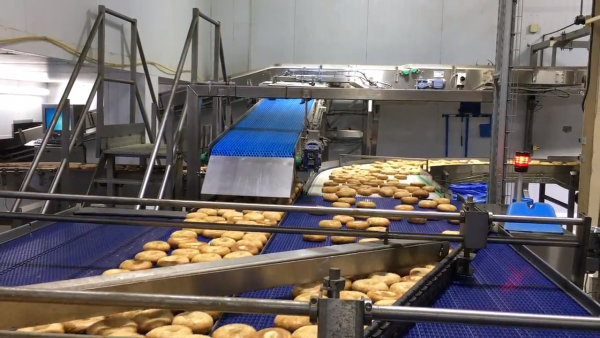In the previous article, we identified the main places bottling lines get hung up during beverage processing. Here, we look 5 common constraints along food packaging lines.
Wrappers/baggers
Like with beverages, in food manufacturing, moving from the processing to packaging can be challenging.
For example, we worked with a client that made bagels. The line moved the bagels from the oven to the cooler to four different bagging machines. The problem was that the baggers would go down relatively often. This would jam the line, causing a huge pileup of bagels on the conveyor, and many of the bagels would fall on the floor. Since they could no longer be safely consumed by humans, the bagels were used for animal food.
The company was losing a full third of their product to animal feed because the bagels fell on the floor.
Putting an accumulation table between the cooler and the bagging machines solved the problem. Reducing product loss and keeping the lines running resulted in a 30% increase in throughput.
Labelers
Labelers are another common spot for bottlenecks. They may need frequent refilling, the label printer may jam, or the die cutters may not function properly (an increasingly common problem as the industry moves toward thinner labels to reduce waste). In any case, if your labeler goes down, the rest of the line must stop as well.
We recently helped a customer increase throughput by installing an accumulation table between the leak detection system and the labelers on a canned food line.
Cappers
Does your capper have a high reject rate? Does faulty cap position or torque control necessitate rework? Are products frequently spilled? All of these can necessitate shutdowns for maintenance.
Check out a case study in which we placed an accumulator between the labeler and cappers on a canned biscuit dough line.
Case packers
Case packers can be an efficiency nightmare. They frequently go down, changeovers can take a long time, and, particularly if you’re packing glass jars or bottles, mistakes can be messy.
Here are a couple of examples of how accumulation can eliminate bottlenecks at case packers:
Fillers
Finally, just like on beverage bottling lines, fillers on food packaging production lines are frequent sources of lost productivity. There are many reasons for this. Sometimes, the machines are simply slower than the rest of the line. Since fillers have food contact surfaces, they can also require extra care and maintenance to ensure food safety. Regardless, we’ve found that installing an accumulation table after, and sometimes before, the filler can have a huge impact on total throughput.
Explore an example where placing an accumulation table between a manually loaded mass conveyor and a filler increased total line efficiency.
Bagels, canned foods, frozen food trays, yogurt, brownies (we didn’t talk about that one, but check it out here) — as you can see, accumulation can boost production throughput for all kinds of products. To discover how much more throughput you could be achieving, request a free Garvey Line Analysis or use our online Line Efficiency Calculator.




